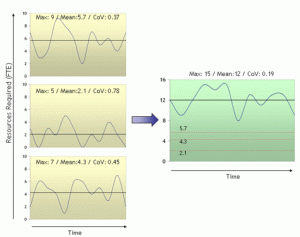Small dedicated work groups: (A misapplication of the value stream concept)
Recently in laboratories, there has been a notable shift towards dedicating resources to specific work streams and sub-streams, in the attempt to improve service levels. This is due in large part to a misapplication of the key Lean principle of developing ‘Value Streams’.
Traditionally in the QC function, there has always been a separation between analytical chemistry, microbiology, raw materials, testing, etc. What is done operationally in these groups is technically different and there is some argument for dedicated groups at this level. However, we are seeing more and more QC groups dedicating individuals and/or teams (within these groups) to specific products and/or tests. With increased pressure on labs to cut cycle times, what better way to ensure prompt service than have dedicated and trained groups waiting for samples and ready to test? Right?
Wrong! This arrangement of small dedicated work groups each with volatile workloads is a significant cause of poor performance. It introduces two of the major wasteful practices, that of an uneven workload (mura) and that of stressed systems (muri). The third wasteful practice is muda, which is more familiar to most people and unfortunately receives all the attention. It is our view that mura and muri must be tackled and solved, otherwise most waste elimination will not be sustained.
Consider what happens when a dedicated group receives few or no samples over a day or two. The dedicated resources will generally share the samples amongst the available analysts, each of which then performs tests sub-optimally. Alternatively if samples are tested optimally by less analysts, there is no option but to fill the other available analysts’ time with ‘busy work’ and Parkinson's Law will apply [i.e. the law first mooted by Cyril Northcote Parkinson in an essay published in The Economist in 1955: Work expands so as to fill the time available for its completion].
The graphs show the resources required to process the incoming workload in full time equivalents (FTEs) for 3 dedicated groups. The individual group averages are 5.7, 2.1 and 4.3 and the Coefficient of Variation (CoV - a normalized measure of volatility) for the individual work streams are 0.37, 0.78 and 0.45. If lead-times are to be maintained, these groups would need to be staffed at 9, 5 and 7 FTEs respectively to deal with the workload peaks (21 FTEs in Total).
Now, consider the impact of combining these 3 work streams. The CoV has been drastically reduced to just 0.19 and the number of FTEs required to deal with the peak workload drops to 15 (a 29% reduction). Also at this level of volatility it would be possible to develop defined repeating sequences of testing (in the form of ‘Rhythm Wheels’ or ‘Trains’) and Standard Work (in the form of analyst roles that uses people’s time well). This would improve productivity further and transform these 3 stressed and unproductive workgroups into one much more productive group.
Of course it is possible that the individual workload peaks could have ‘stacked up’ and that the combined CoV would have increased. In real life applications we prevent this from happening by using devices like ‘Leveling Queues’ or ‘Pacemaker scheduling’.
While we strongly agree with the concept of organizing along the value stream, we caution against dedicating resources to sub-streams without understanding and considering what the overall performance impact will be. This is especially important if the sub-streams are known to have volatile workloads and/or short term demand volatility. This is very common in the Pharmaceutical and Biotechnological industries where products are manufactured in campaigns followed by significant changeover times.
Our consultants can provide further information on the above and discuss any aspect of Real Lean Transformation, simply set-up a call today.


